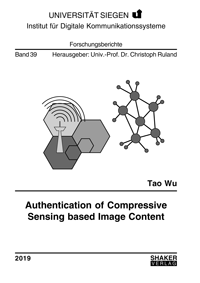
Shop : Details
Shop
Details

March 2019
Tao Wu
Authentication of Compressive Sensing based Image Content
Compressive Sensing (CS) has redefined the sampling method by choosing an appropriate sensing domain, limiting the characteristics of source information, and performing recovery with a nonlinear solver. CS-based Imaging (CSI) cameras can construct an N pixel image with only M measurements where M ≪ N, and the sampling bandwidth of sensors is not limited when the target image can be k-sparse or "compressible"
represented. It is necessary for CS based images to be protected by an authentication mechanism that can provide the integrity and authenticity of the origin.
This dissertation proposes an authenticated CSI system that is based on the Compressive Sensing based Message Authentication Code (CSMAC) mechanism. This MAC method is embedded in the imaging process with a redundant secure matrix. Furthermore, the extraction mechanism may reduce the data size and support a restricted tolerance property. With the help of a pre-trained threshold the verifier can tolerate an appropriate amount of recovery noise and detect the content modifications.
This study finally proposes an authenticated encrypted CSI mechanism, in order to support authentication, encryption, compression and sensing in one step. Since CS based images denote a poor data compression performance, an improvement is suggested as a basis for the authenticated encrypted CSI mechanism is based. The simulated results illustrate that CSI is computationally secure for confidentiality, sensitive to the amount of content-based tampering, and has an approximately 20% lower bit-rate for an acceptable image resolution compared to the naive CSI method.
This dissertation proposes an authenticated CSI system that is based on the Compressive Sensing based Message Authentication Code (CSMAC) mechanism. This MAC method is embedded in the imaging process with a redundant secure matrix. Furthermore, the extraction mechanism may reduce the data size and support a restricted tolerance property. With the help of a pre-trained threshold the verifier can tolerate an appropriate amount of recovery noise and detect the content modifications.
This study finally proposes an authenticated encrypted CSI mechanism, in order to support authentication, encryption, compression and sensing in one step. Since CS based images denote a poor data compression performance, an improvement is suggested as a basis for the authenticated encrypted CSI mechanism is based. The simulated results illustrate that CSI is computationally secure for confidentiality, sensitive to the amount of content-based tampering, and has an approximately 20% lower bit-rate for an acceptable image resolution compared to the naive CSI method.
Keywords: Compressive Sensing; Authentication; Imaging
Forschungsberichte des Instituts für Digitale Kommunikationssysteme
Edited by Prof. Dr. Christoph Ruland, Siegen
Volume 39
Available online documents for this title
You need Adobe Reader, to view these files. Here you will find a little help and information for downloading the PDF files.
Please note that the online documents cannot be printed or edited.
Please also see further information at: Help and Information.
Please also see further information at: Help and Information.
| Document |  | Document | ||
| Type |  | |||
| Costs |  | 34,35 € | ||
| Action |  | Purchase in obligation and download the file | ||
| Document |  | Table of contents | ||
| Type |  | |||
| Costs |  | free | ||
| Action |  | Download the file | ||
User settings for registered online customers (online documents)
You can change your address details here and access documents you have already ordered.
User
Not logged in
Export of bibliographic data
Shaker Verlag GmbH
Am Langen Graben 15a
52353 Düren
Germany
Am Langen Graben 15a
52353 Düren
Germany
Mon. - Thurs. 8:00 a.m. to 4:00 p.m.
Fri. 8:00 a.m. to 3:00 p.m.
Fri. 8:00 a.m. to 3:00 p.m.
Contact us. We will be happy to help you.

